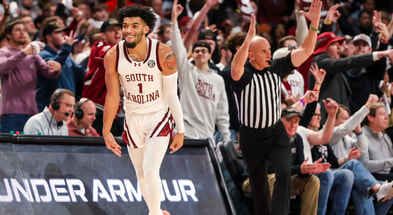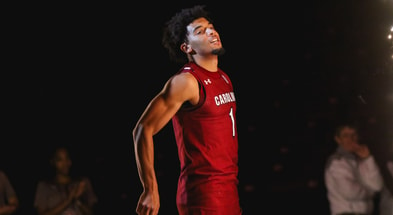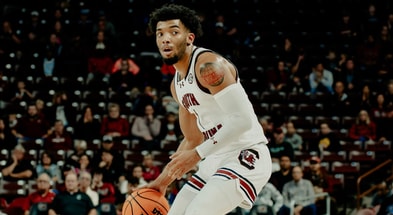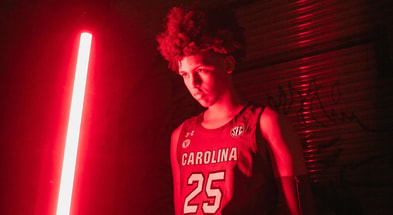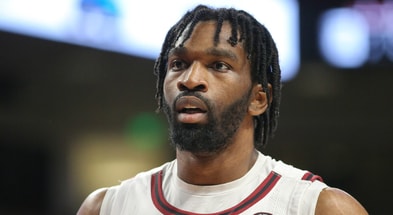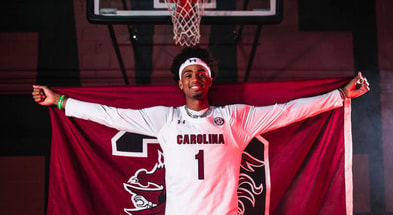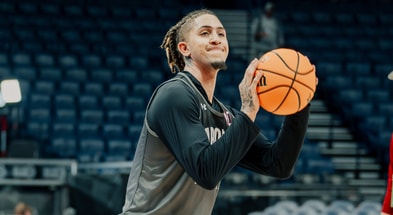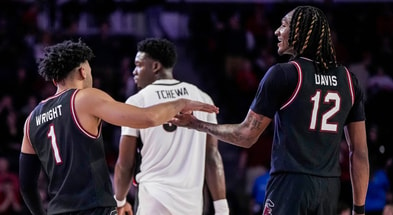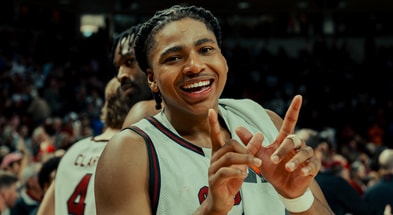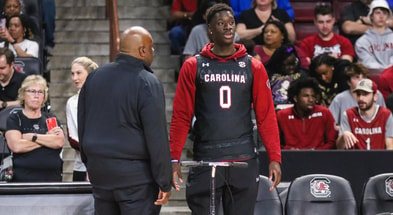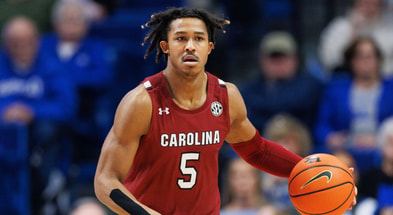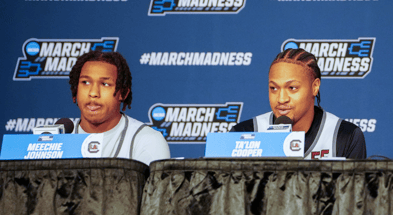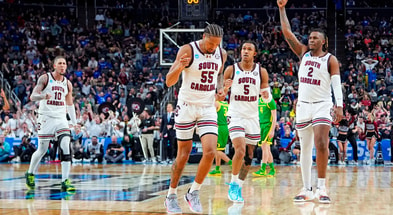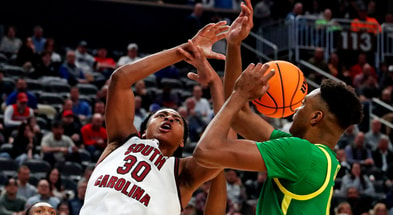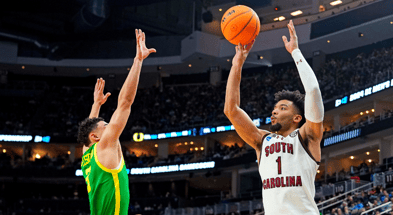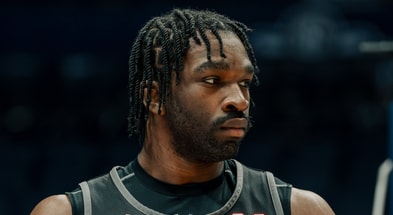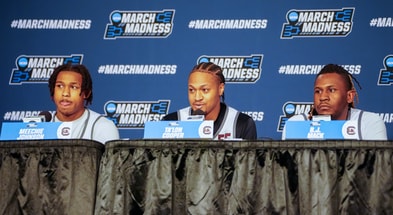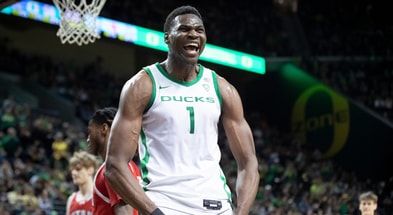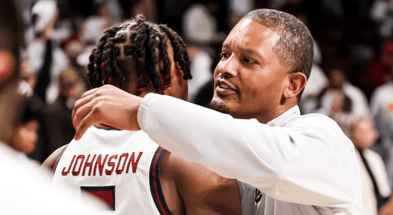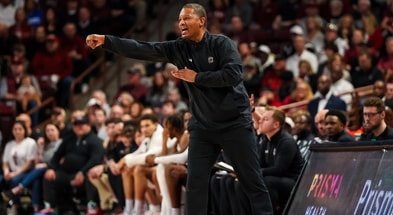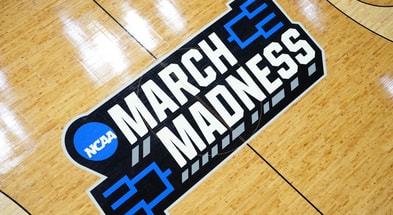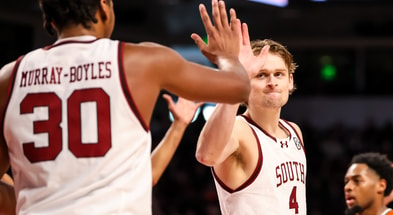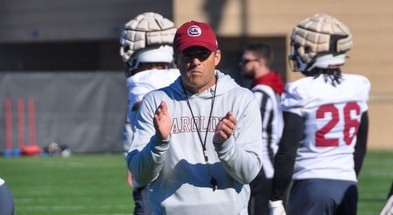South Carolina is the Scoringest State
Alan Piercy is the author of A Gamecock Odyssey: University of South Carolina Sports in the Independent Era (1971-1991). The following was originally published on Alan’s South By Southeast newsletter.
Five NCAA scoring champions with Palmetto State ties boast seven men’s basketball scoring championships between them, the most of any state. And then there’s Pearl Moore.
Their names ring out like worn leather through scorched nylon and the squeak of high-top sneakers on varnished wood. Frank Selvy, Darrell Floyd, Grady Wallace, Zam Fredrick, and Xavier McDaniel. They are comprised of two Kentucky transplants who somehow escaped the grasp of Adolph Rupp, one under-the-radar Tar Heeler, and two native South Carolinians, who cumulatively led the NCAA in scoring across seven seasons for the Paladins, the Gamecocks, and the Shockers of Wichita State.
Their names are etched in bronze now and their jerseys forever adorn the rafters of arenas in Columbia and Greenville and Wichita, Kansas.1 Their legacies speak to gaudy stats and sepia-toned greatness.
Since the mid-1930’s, available records reflect the top individual scorer for each season across NCAA men’s basketball. Between the 1935-36 and 1946-47 seasons records were kept by the National Basketball Committee, an NCAA-adjacent governing body. The NCAA considers those records “unofficial,” and starting with the 1947-48 season began keeping its own official records.
During an unprecedented stretch of five consecutive seasons, from 1952-53 through 1956-57, the Palmetto State boasted five-straight national scoring titles, led by Furman University’s Selvy and Floyd, with two titles apiece. The University of South Carolina’s Grady Wallace followed with a title of his own in 1957.
Only four other states can boast consecutive scoring champions. Ohio and Louisiana each claimed three-straight titles on the efforts of legends Oscar Robinson of Cincinnati (1957-60) and “Pistol” Pete Maravich of LSU (1967-70). Oregon, meanwhile, claims two-consecutive championships with Portland State’s Freeman Williams (1976-78). Likewise, Virginia claimed two-consecutive titles with VMI’s Reggie Williams (2006-08).
The University of South Carolina’s Wallace (who I wrote about here) is the only scoring champ from among the original eight ACC schools.2 The Gamecocks’ Zam Fredrick achieved his title during the 1980-81 season, a decade after USC departed the ACC, and before Metro, and eventually SEC membership.
The SEC, meanwhile, claims four titles, highlighted by Maravich’s three-straight between 1967-70.3 In an interesting turn, the conference claimed a fourth-straight title when Johnny Neumann of Ole Miss captured the scoring championship during the 1970-71 season.
The seven scoring championships by players with South Carolina ties is equalled only by New York for the most titles of any state.4 Louisiana, California, Georgia, and Texas boast six apiece, while Virginia claims five. Interestingly, the smallest state, Rhode Island, dominated the “unofficial” record period from 1935-1947 with six titles during that time, and added an additional two since 1948.
[GamecockCentral for $1: In-depth coverage and a great community]
Frank Selvy (1952-53 and 1953-54)
From Corbin, Kentucky, Selvy was initially overlooked by the University of Kentucky’s legendary coach Adolph Rupp due to his relatively diminutive size. By the time he hit a growth spurt, reaching six-four in his senior year, and subsequently winning MVP in the Kentucky East-West all-star game, Rupp took notice and offered a scholarship. But Selvy had already committed to Furman’s Coach Lyles Alley.
Selvy famously scored 100 points in a game versus Newberry College on Feb. 13, 1954, still an NCAA record. It was the final home game of Selvy’s collegiate career, and the first game his mother had witnessed since high school. Played at Greenville’s Textile Hall, the game was reportedly the first televised sporting event in the state of South Carolina.
Coach Alley’s game plan was a simple one – get the ball to Selvy, who by then, had already secured his second straight national scoring title. Selvy hit on 41 of 66 field goals and 18 of 22 free throws. His final bucket was a near half-court heave at the buzzer, which put him into triple-digits, sending fans into a frenzy.
The number-one overall pick in the 1954 NBA draft by the Baltimore Bullets, Selvy played twelve seasons, earning two NBA All-star awards, in 1955 (his rookie season) and 1962. Selvy spent the final six seasons of his NBA career playing alongside the likes of Jerry West and Elgin Baylor with the Los Angeles Lakers.
Following his NBA career, Selvy returned to Furman as an assistant coach under his college mentor Alley, then succeeded Alley as head coach from 1966-1970.
Darrell Floyd (1954-55 and 1955-56)
Floyd, from Thomasville, North Carolina, played his freshman season at tiny Wingate Junior College (now Wingate University) near Charlotte. Floyd earned junior college all-America honors, and caught the attention of Alley at Furman. He played his sophomore season for the Paladins alongside Selvy in 1953-54, then went on to capture two-consecutive scoring titles of his own, becoming only the second-ever consecutive scoring champ.
Floyd was selected in the third round of the NBA draft by the St. Louis Hawks, but contract negotiations broke down when the Hawks could not offer enough to surpass what Floyd earned as a heavy machinery salesman in Greenville. Floyd never played professional basketball, serving for a time in the US Army, and later as businessman in Greenville.
Grady Wallace (1956-57)
Nicknamed “The Quiet Kentuckian” for his low-key manner, Wallace hailed from the hardscrabble mining town of Mare Creek, in the coal-haunted hill country of Eastern Kentucky.
Wallace burned the nets down for the Gamecocks during his senior season of 1956-57, becoming the fifth-straight national scoring champion from a South Carolina school. In the process, he beat out higher-profile players, like Wilt Chamberlain of Kansas and Elgin Baylor of Seattle.
NC State’s Norm Sloan once said of Wallace, “Sure, he has a weakness. I noticed he doesn’t dribble too well with his left foot.”
In two seasons, Wallace scored 1,456 points for a career average of 28.0. To put that into perspective, the great John Roche ranks second in program history with a distant 22.5 points per game (ppg). No player in the three-point era has come close. Wallace’s single season point total of 906, and his 31.24 ppg average in 1956-57 is still a program record and remains second-best in ACC history (Virginia’s Buzzy Wilkinson, who played from 1953-55 is in first place). Wallace also managed to lead the ACC in rebounding in 1957.
The NBA’s Boston Celtics drafted Wallace in 1957, but he opted instead to play two seasons for the Industrial League’s Phillips 66’ers in the days before professional basketball became a path to riches. Wallace went on to a successful career with the South Carolina Department of Probation, Pardon and Parole, ultimately retiring as Commissioner. In his spare time, he coached Columbia’s Cardinal Newman High School for nine seasons, winning two state championships.
The University of South Carolina retired Wallace’s #42 jersey in 1957, and he was inducted into the South Carolina Athletics Hall of Fame in 1968.
Zam Fredrick (1980-81)
First-year Gamecock coach Bill Foster said of Fredrick’s emergence during the 1980-81 season, “We figured we had a fine athlete who we could work with, adding, “we didn’t plan to accentuate him like we have.”
The senior from St. Matthews, South Carolina enjoyed an outstanding senior season through mid-January, but was a man possessed during a six-game stretch later that month in which he averaged 35.2 ppg, averaging 56.7 percent from the floor, and moving from twentieth to second in the NCAA scoring race by the first week of February.
Fredrick scored 39 and 43 points respectively during his final two games to overtake Cal Irvine’s Kevin Magee for first place nationally, and held on to win USC’s second-ever national scoring title.
Fredrick was selected in the third round of the NBA draft in 1981, but played professionally in Europe through the 1987 season. He has gone on to tremendous success as head coach of Calhoun County High School in his native St. Matthews, leading that program to five state championships during his decades-long coaching career.
Fredrick was selected to the USC Athletics HOF in 2002. His son, Zam, Jr. starred at South Carolina from 2007-09.
Xavier McDaniel (1984-85)
McDaniel, a Columbia native and AC Flora High School product, grew up pulling for the hometown Gamecocks, and dreamt of wearing the Garnet & Black. When he was not recruited heavily by USC’s Coach Bill Foster and staff during his senior season at Flora, McDaniel accepted a scholarship offer at Wichita State in Kansas.5
McDaniel enjoyed a stellar career for the Shockers, leading the nation in scoring during his senior campaign in 1984-85, becoming the only player in history to lead the NCAA in both scoring and rebounding in the same season.
Selected fourth over-all in the 1985 NBA draft by the Seattle SuperSonics, McDaniel became known for his physical style of play, and established himself as one of the most recognizable NBA stars of the ‘80’s and 90’s for the SuperSonics, Suns, Knicks, and Celtics.
And then, there’s Pearl Moore
With an admiring tip of the cap to Caitlin Clark, the top scorer in men’s or women’s Division I history, the greatest scorer in the history of collegiate basketball at any level is Florence, South Carolina’s own Pearl Moore of Francis Marion University. Moore scored 4,061 points (to Clark’s 3,951), and averaged nearly 31 points per game over 127 games.
Like the men highlighted previously, Moore’s exploits occurred in an era before the three-point line, making her accomplishment all the more mind-boggling.
To put her record into further perspective, BJ McKie, the leading scorer in Gamecock men’s basketball history, scored 2,119 points during his All-American career, with the notable advantage of the three-point line. Moore’s margin over McKie (1,942) would be good for third all-time in Gamecock men’s history, only three points behind second-place Alex English.
“A slept-on state”
During the 2023-24 season, the streaming service Gamecocks Plus produced a series chronicling second-year Gamecock coach Lamont Paris and his efforts to rebuild USC’s program from near anonymity to competitiveness in the rugged SEC. The first episode, titled “A Slept-on State,” documents the under-rated level of basketball talent in the Palmetto State, and the role of South Carolina natives on the most successful squads in program history.
Indeed, when college basketball fans think of legendary programs, their minds turn naturally to the likes of Kansas, Kentucky, UCLA, and, of late, UConn. Of course, the great programs in North Carolina are included among that elite company. UNC and Duke, whose campuses sit a scant 12 miles apart, claim 11 titles between them. Even N.C. State has two titles to its credit, and just last month completed another thrilling Final Four run.
Despite intermittent flashes of brilliance, no men’s program from the state of South Carolina can boast team success on par with that, though Dawn Staley’s Gamecock program is the unquestioned gold standard in today’s women’s game.
Likewise, other states more readily capture the collective imagination of the college basketball world. Kansas, the adopted home of none other than James A. Naismith, the inventor of the game; Indiana, with its storied Hoosier lore, Kentucky, with its gilded Bluegrass history, North Carolina, with its incandescent Tobacco Road rivalries, and California, with its golden-hued legend of John Wooden.
But the Palmetto State takes a backseat to no other when it comes to the individual talent of its native and adopted sons and daughters. Since 1948, South Carolina can truly lay claim to the scoringest state.
[Newsletters: Get breaking news and analysis from GamecockCentral]
Article footnotes
1) All but Fredrick have been honored by their respective universities with retired numbers/jerseys. Fredrick was primarily a role player during his first three seasons at the University of South Carolina under Coach Frank McGuire. When Bill Foster replaced McGuire for the 1980-81 season, Fredrick’s senior campaign, Foster’s more up-tempo offense better suited Fredrick’s skillset, and the senior went on a rampage, leading the country with a 28.9 ppg average.
One could argue (and I do) that Fredrick’s jersey should be retired by USC, given that he is one of only two players in program history to win the national scoring title (the other, Wallace, was the first number retired by the program in 1957). One of USC’s listed criteria for jersey retirements is conference player of the year honors, a distinction Fredrick had no opportunity to earn, given USC’s independent status at the time. There must be additional consideration given beyond the university’s current criteria for exceptional players of the independent era, between membership in the ACC and Metro (1972-1982).
2) USC’s Grady Wallace is the only national scoring champion among the founding ACC schools, which included USC, Clemson, Duke, NC State, UNC, Wake Forest, Maryland, and Virginia. Current ACC member Miami secured the state of Florida’s lone scoring champion with Rick Barry’s title in 1964-65, while Virginia Tech’s Erick Green captured the title in 2012-13. (The state of Virginia boasts four additional winners – three from VMI and one from Richmond).
3) Maravich’s three varsity seasons include the top three scoring seasons in NCAA men’s basketball history, topped by his senior season of 1969-70 when he averaged an incredible 44.5 ppg. His junior and sophomore seasons were not far behind, with averages of 44.2 and 43.8, respectively. Only two other scoring champions have averaged 40+ ppg, including Ole Miss’ Johnny Neumann (40.1 ppg), and Furman’s Frank Selvy, who secured his second scoring title in 1954 with a 41.7 ppg average.
4) Using my criteria, which includes a combination of native players, (Fredrick), those from SC who played elsewhere, (McDaniel), and players from other states who made their mark at SC colleges, (Selvy, Floyd, and Wallace), other states would naturally claim more titles than first meets the eye. Kentucky, for example, can claim only two titles from individuals who played their college careers within the borders of the Bluegrass State. By my criteria, they could add at least two more (Selvy and Wallace), and likely more. This post is not intended to be an exhaustive review of all those various cross streams. Though, that would make an excellent research topic for somebody inclined to tackle it.
5) McDaniel’s teammate at AC Flora, Tyrone Corbin, also left South Carolina for his collegiate career, staring at DePaul from 1981-85 before embarking on his own successful NBA playing career. The staggering recruiting misses on McDaniel and Corbin were among the greatest failures of the Bill Foster era at USC.
